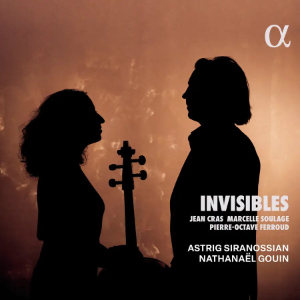
Invisibles
Jean Cras (1879-1932)
Cello Sonata (1901)
Pierre-Octave Ferroud (1900-1936)
Cello Sonata in A (1932)
Marcelle Soulage (1894-1970)
Cello Sonata in F sharp minor (1919)
Astrig Siranossian (cello)
Nathanaël Gouin (piano)
rec. 2024, Salon Gustav Mahler of the La Grange-Fleuret Music Library, Paris
Alpha Classics 1085 [64]
These three French cello sonatas encompass the years 1901 to 1932, though they represent different stages in their composers’ careers. Jean Cras’s Sonata was written when he was 22 and serving as a naval cadet and seems largely to have been written when he was on board his ship, the St Louis, part of France’s Mediterranean fleet. Cras had received inspiration from his newly-acquired teacher, Henri Duparc, under whose influence the sonata was composed, and the thirty-minute, three-movement work, written along conventional structural lines, is doused in fiery late-Romanticism. Stirring and striking, its first movement’s second subject offers a satisfying contrast, whilst the meditative cello in the central Adagio has an underlying rocking (almost marine) accompaniment which provokes the cello to increased ardour. The grave four-minute introduction of the finale is followed by plenty of Vif which includes reminiscences of earlier material and a resumption of the yearning romanticism and reverie that had earlier coursed through its veins. It’s rather too long for its own good, being critical, but it shows signs of the subtle sense of atmosphere that Cras was to develop later in life.
Though it was composed in 1932 when Pierre-Octave Ferroud was still only 32, his Cello Sonata in A is, in effect, a late work, as Ferroud died in a car accident four years later – a fellow passenger, and survivor, was the Hungarian composer László Lajtha. This playful, crisp and chic work is a delight. It was dedicated to Prokofiev and premiered by Maurice Maréchal and Robert Casadesus in Paris in April 1933 and is a study in light-heartedness and intelligent frivolity. Its Poulenc-like wit is enhanced by a lovely lied-like songful central Intermezzo and the good-natured joie de vivre of his finale ends a work of delightful charm.
It would be exaggerating to say that I’ve been deluged by the works of Marcelle Soulage but I’ve recently reviewed two recordings of her Viola Sonata and have come across other pieces by her that attest to a strong and increasing level of interest in her music. She was clearly a sophisticated explorer of equal dialogues between her protagonists in these string sonatas – the cello’s range is wide and there’s a vivid conversational sense. Piano chording is strong, the cello’s Nocturne in the central movement is by no means inert – on the contrary, it’s projected with a sense of stylish movement. Her finale here is biting, lithe and exciting. Soulage is a fine composer and this sonata, written in her mid-20s, is an excellent example of her skill in musical mapping and characterful voicing.
Astrig Siranossian and Nathanaël Gouin are ardent champions of this music and draw on its passion and charm alike in exemplary fashion. I thought at first, with Cras’s intensity, that the recording, though well-balanced, might turn out to be rather monochromatic but that’s not the case. It’s perfectly fine. There are a few misspellings and typos in the three-language booklet notes (French, English, German) but otherwise all is well.
Jonathan Woolf
Buying this recording via a link below generates revenue for MWI, which helps the site remain free



















